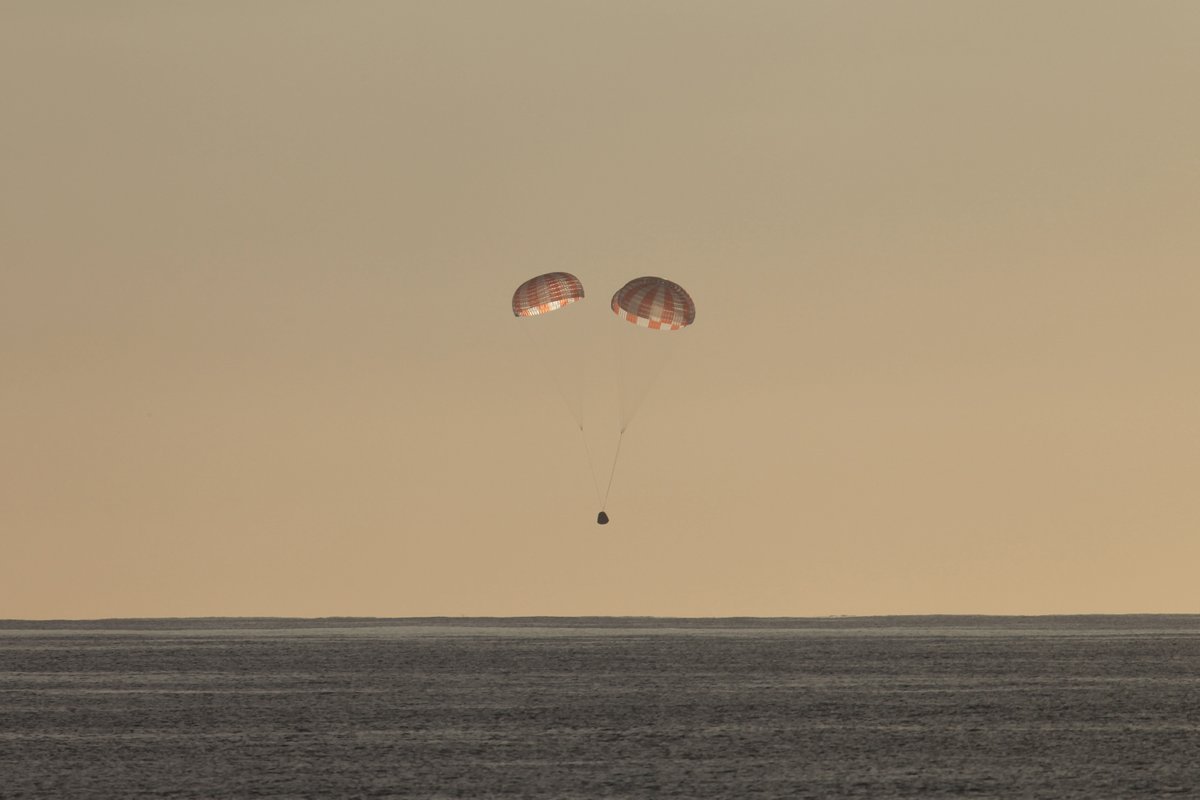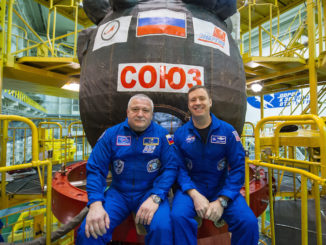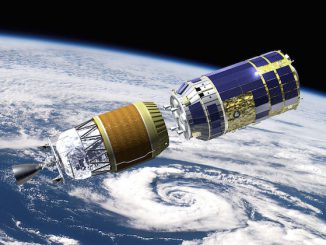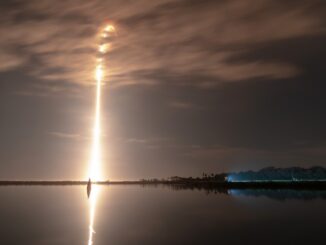
For the final time, a SpaceX Dragon cargo capsule was released from the International Space Station’s robotic arm Tuesday and splashed down hours later in Pacific Ocean southwest of Los Angeles. Beginning later this year, SpaceX will fly upgraded Dragon freighters that will dock automatically with the space station and parachute into the Atlantic Ocean east of Florida.
The unpiloted cargo capsule splashed down in the Pacific Ocean at 2:50 p.m. EDT (11:50 a.m. PDT; 1850 GMT) Saturday, bringing home more than 4,000 pounds of scientific experiments and other equipment, according to NASA.
SpaceX teams on station in the Pacific were expected to approach the floating spacecraft and hoist it aboard a recovery ship for the trip to the Port of Los Angeles, where ground crews will begin unloading the cargo inside the capsule.
The specimens packed inside the Dragon spacecraft for Tuesday’s return to Earth included live mice, plant cells grown on the space station, and an array of other biological and pharmaceutical research experiments.
The mice that rode the Dragon back to Earth on Tuesday are part of a Japanese research investigation studying how gene expression in the cells of the animals may have been altered after a long-duration spaceflight. The mice were housed in a centrifuge-equipped experiment facility on the station, where they lived under partial gravity conditions.
Researchers want to study now the mice responded to the partial gravity, and the results could be applied to preparations for future long-term human expeditions in space, according to NASA.
Refrigerated samples from an experiment that looks at how bone cells react to microgravity were also returned to Earth on Tuesday. The bone cells flown in space will be compared with bone cells that were magnetically levitated in a ground-based lab, allowing scientists to determine whether magnetic levitation accurately simulates microgravity.
Studying bone cells like those flown on the space station could help researchers develop treatments for medical conditions that cause bone loss.
Also aboard the Dragon capsule were samples from an experiment that studied the generation of cardiomyocytes, specialized heart muscle cells, for use in research and clinical applications, according to NASA. Research shows the cardiomyocytes generated in microgravity could have improved yield and purity, and further studies could help scientists create heart tissues for use in regenerative medicine, disease modeling and drug discovery, NASA said.
Samples from another experiment to evaluate changes and mutations in coffee and hemp plant cells in microgravity were also flown back to Earth on Tuesday.
The BioFabrication Facility, developed by an Indiana company named Techshot, also returned to Earth on Tuesday inside the Dragon capsule. Designed to 3D-print soft human tissue in microgravity, the facility could demonstrate capabilities researchers view as a stepping stone toward potentially manufacturing organs for transplant patients.
Techshot plans to upgrade the bioprinter, and experts will examine the properties of a knee meniscus printed aboard the space station.

The splashdown in the Pacific on Tuesday occurred hours after the Dragon capsule departed the space station.
Ground controllers at NASA’s Johnson Space Center in Houston commanded the station’s Canadian-built robotic arm to release the Dragon spacecraft at 9:06 a.m. EDT (1306 GMT). The Dragon fired thrusters to fly away from the station, setting up for a braking burn at 1:58 p.m. EDT (1758 GMT) to drop into Earth’s atmosphere for re-entry.
The Dragon jettisoned its disposable unpressurized trunk and deployed parachutes to gently descend into the Pacific.
The Dragon spacecraft arrived at the space station March 9, following launch March 6 aboard a Falcon 9 rocket from Cape Canaveral. It delivered 4,358 pounds (1,977 kilograms) of cargo and experiments to the station, including a new European-built outdoor science deck to accommodate external experiments.
The return Tuesday marked the end of the third flight of this particular Dragon capsule, and the final mission under a 20-flight Cargo Resupply Services contact between SpaceX and NASA.
The end of the Dragon mission Tuesday marks the transition to SpaceX’x next CRS contract with NASA. SpaceX’s next series of cargo missions will use a new Dragon spacecraft design known as the Dragon 2. Cargo flights to the space station using the Dragon 2 spacecraft are scheduled to begin in late October.
The Dragon 2’s human-rated variant is named the Crew Dragon, which is scheduled to fly astronauts to the space station for the first time as soon as late May.
The first-generation version of the Dragon spacecraft debuted in 2010 with a test flight in low Earth orbit. The Dragon capsule accomplished its first trip to the International Space Station in May 2012 on a second demonstration mission under NASA’s Commercial Orbital Transportation Services, or COTS, program.
Through the COTS program, NASA contributed $396 million toward the development of the Dragon spacecraft and Falcon 9 launcher in a public-private partnership with SpaceX. NASA says SpaceX contributed roughly $450 million to the effort.
With the COTS demonstrations accomplished, SpaceX began regular cargo transportation services to the space station in October 2012 under the CRS contract. In 2014, SpaceX won a NASA competition to develop an upgraded Dragon spacecraft to ferry astronauts to and from the station.
The commercial cargo and crew transportation agreements were designed to give NASA a way to get astronauts, experiments, space parts and other equipment to the space station after the retirement of the space shuttle in 2011.
Northrop Grumman is NASA’s other commercial cargo transportation provider, and Boeing joined SpaceX as the other contractor the commercial crew program.
Since the initial contract award in 2008, NASA has extended the CRS agreement with SpaceX from 12 missions to 20 flights.

The Dragon capsule itself has performed well on all its missions, successfully reaching the space station and returning to Earth on all but one flight. A Falcon 9 rocket failed during launch on a resupply flight in June 2015, destroying a Dragon spacecraft and its cargo load.
Counting the test flights and the failed launch, SpaceX has launched 22 missions using the first-generation Dragon spacecraft.
The missions carried more than 94,000 pounds (43 metric tons) of cargo to the International Space Station, and returned about 74,000 pounds (33 metric tons) of equipment and specimens to Earth, according to NASA.
SpaceX launched its last new first-generation Dragon spacecraft in August 2017. Since then, the company has reused Dragon vehicles that were refurbished after splashing down in the Pacific Ocean.
NASA awarded a second Commercial Resupply Services contract to SpaceX in 2016. Orbital ATK — now part of Northrop Grumman — and Sierra Nevada Corp. also received CRS-2 contracts to resupply the space station through the mid-2020s.
Northrop Grumman launched its first CRS-2 mission using upgraded versions of its Antares rocket and Cygnus supply ship last November, and Sierra Nevada’s Dream Chaser space plane is scheduled to fly to the space station for the first time in 2021.
The Dragon 2 has a different aerodynamic shape than the first-generation Dragon, and it has body-mounted solar arrays to generate electricity, replacing the extendable wings on the first version of the Dragon spacecraft.
It can also dock automatically with the space station, without requiring station crews to capture it with the research lab’s Canadian-built robotic arm. That means Tuesday’s departure of the cargo capsule was the final time a Dragon spacecraft will be released robotically.
The cargo version of Dragon 2 will launch without seats, cockpit controls and other life support systems required to sustain astronauts in space. The cargo version will also launch without the SuperDraco escape thrusters fitted to human-rated Dragon capsules.
While SpaceX and NASA do not initially plan to reuse Dragon 2 capsules for crew missions, the cargo variant will be qualified to fly to the space station and back to Earth up to five times, officials said. The first-generation Dragon capsule was capped at three missions.

Beginning with the CRS-21 mission late this year, the new Dragon 2 cargo capsules will splash down under parachutes in the Atlantic Ocean east of Florida, rather than the current recovery zone in the Pacific Ocean west of Baja California. It takes a day or two for Dragon capsules to get back to port in California on SpaceX recovery ships. That transit time will be cut with splashdowns in the Atlantic.
“When they do that, they’ll be a matter of hours from the port,” said Kenny Todd, NASA’s manager of International Space Station operations and integration, last month. “So that will allow us to get this critical science back in the investigators’ hands much quicker.”
The Dragon 2 will be able to carry more cargo to the space station. But the Dragon 2’s primary arrival mode, using docking rather than capture and berthing with the robotic arm, comes with a limitation.
The hatches through the space station’s docking ports are narrower than the passageways through the berthing ports currently used by Dragon cargo vehicles.
Northrop Grumman’s Cygnus supply ship and Sierra Nevada’s Dream Chaser space plane are designed to berth to the space station, offering transportation for bulkier items.
NASA astronaut Drew Morgan monitored Tuesday’s Dragon departure from the space station.
“That was the last time the arm and Dragon will meet that way so it was fun to watch,” Morgan said. “Congratulations to the SpaceX team and the teams all around the world for the successful Dragon mission over the last month and wrapping up Expedition 62.”
Morgan and crewmates Jessica Meir and Oleg Skripochka will be joined by three fresh crew members Thursday, then they will head for landing in Kazakhstan on April 17 on a Russian Soyuz capsule.
Email the author.
Follow Stephen Clark on Twitter: @StephenClark1.



